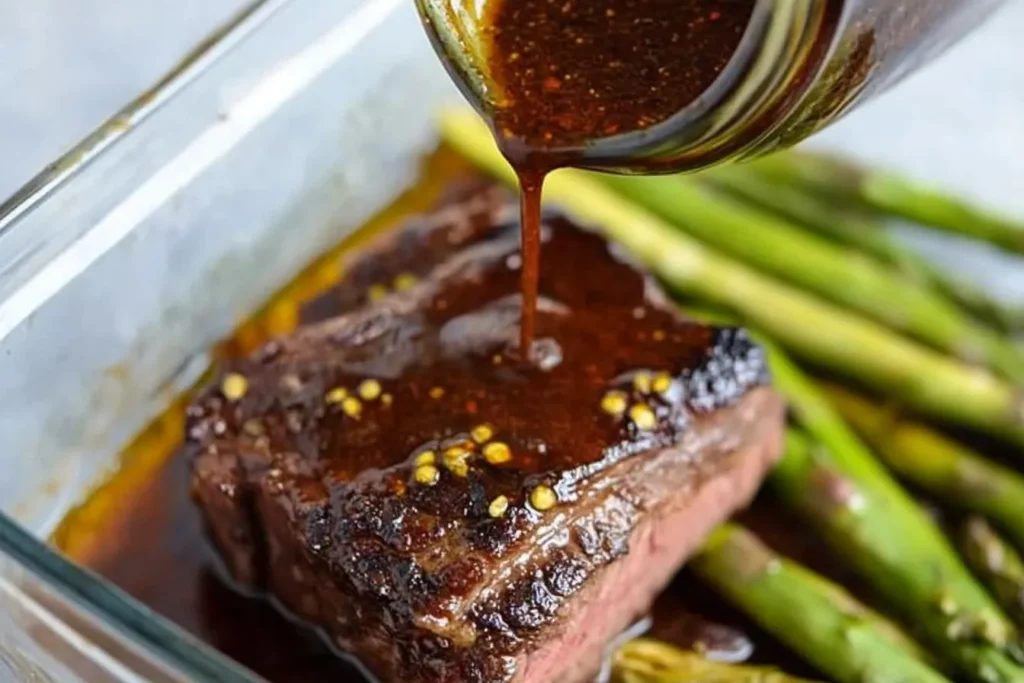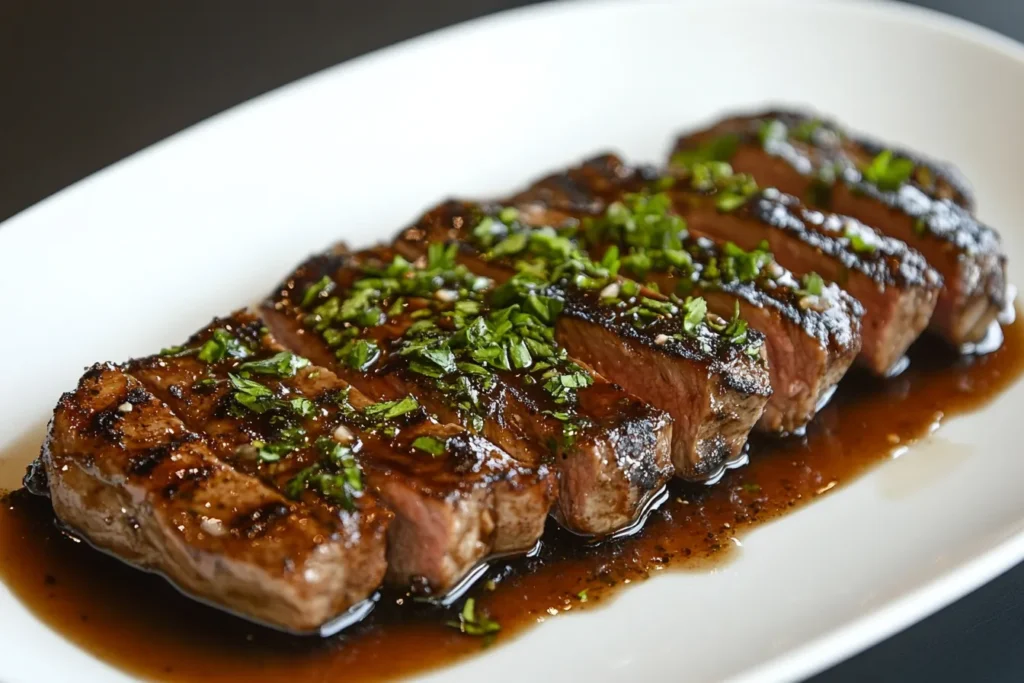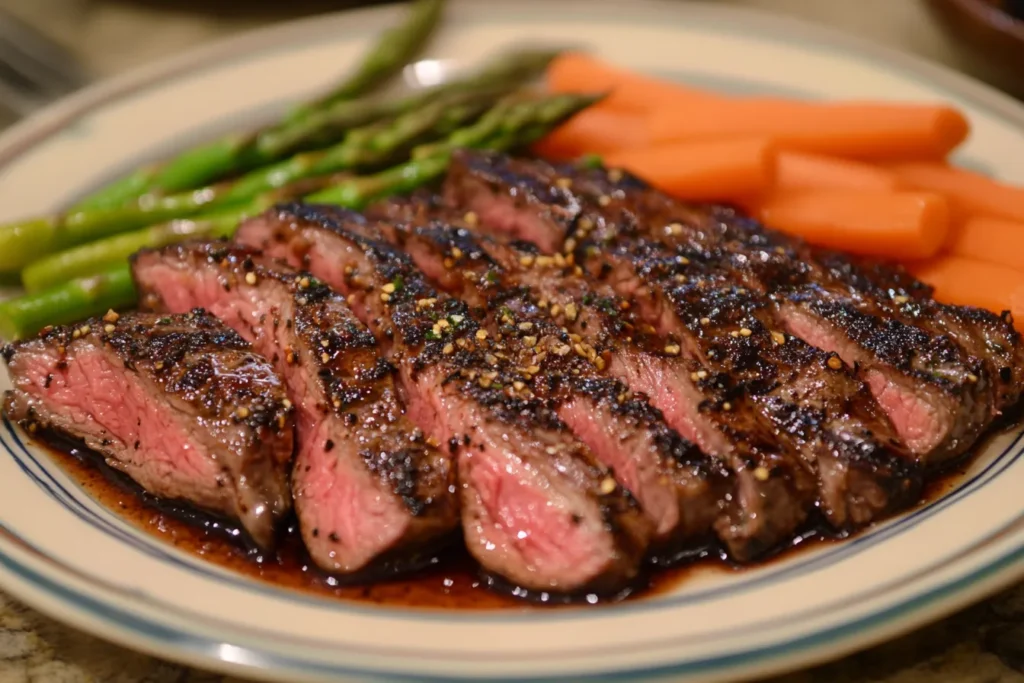Have you ever wanted to make steak that’s bursting with flavor but felt overwhelmed by all the complicated marinades out there? You’re not alone! Sometimes, less is more, and that’s exactly why this 3-ingredient steak marinade is a game-changer. With just three simple pantry staples, you can transform an ordinary steak into a juicy, flavorful masterpiece—without any stress or fuss. I get it—life’s busy, and you don’t always have time to measure out a dozen ingredients. That’s why I love this recipe; it’s quick, easy, and delivers incredible results every time. Ready to elevate your next steak night? Let’s dive in!
List Of Contents
What is a 3-Ingredient Steak Marinade?
A 3-ingredient steak marinade is a simple yet effective way to infuse your steak with robust flavor using only three key components. Furthermore, these marinades are crafted to achieve a balance of tenderness, moisture, and taste without overwhelming the meat or requiring a pantry full of ingredients. Check out more recipes here.
Why Opt for a Minimalist Marinade?
- Ease of Preparation: Since three ingredients mean less prep time and fewer steps, this recipe is accessible even for beginners.
- Maximized Flavor: When chosen carefully, each ingredient plays a distinct role, resulting in an ideal combination of taste and texture.
Explore the power of minimalism in cooking with an expertly crafted marinade that’s both straightforward and impactful.
Why Choose a Simple Marinade for Steak?

The Science Behind Marinades
Marinades work by breaking down the proteins in the meat through acidic and enzymatic reactions. A simple marinade allows these processes to enhance the steak’s natural flavors rather than mask them. The key elements—acid, oil, and flavor enhancers—are carefully balanced to create the perfect bite. Check out sweet recipes here.
Convenience and Flavor Balance
A minimalist marinade offers:
- Faster preparation: Ideal for busy weeknights or impromptu barbecues.
- Balanced flavor: Ensures the steak’s natural taste remains the hero of the dish.
For more information on the role of acid in tenderizing meat, check out this in-depth guide.
Key Components of a Perfect Marinade
A perfect steak marinade relies on three crucial ingredients, each serving a specific purpose:
1. Acidic Elements
Acids such as vinegar, citrus juice, or wine help break down the steak’s tough fibers, ensuring a tender texture.
Common choices include:
- Lemon or lime juice
- Balsamic or apple cider vinegar
- Buttermilk
2. Oil
Oil acts as a carrier for the marinade’s flavors while preventing the steak from drying out during cooking. It also ensures even cooking by reducing stickiness.
Popular options:
- Olive oil for a fruity, robust flavor
- Vegetable oil for neutral profiles
3. Flavor Enhancers
The third component adds the signature taste. Whether it’s a hint of umami or a punch of spice, this ingredient elevates your steak.
Favorites include:
- Soy sauce for a salty depth
- Fresh garlic for aromatic zing
- Herbs like rosemary or thyme for earthy notes
For more ideas on selecting the best oil and flavor enhancers, explore this helpful article.
The Benefits of Using Only Three Ingredients
Cost-Effectiveness
Using only three ingredients minimizes expenses while still delivering a high-quality marinade. Each element is versatile, often doubling as a pantry staple.
Simplifying Meal Prep
Consequently, a minimalist approach means fewer measurements, less cleanup, and faster decision-making. Whether you’re a culinary novice or an experienced chef, the simplicity ensures a no-fail process every time.
Understanding the Role of Each Ingredient
Acid
Acids such as vinegar or lemon juice are the backbone of a marinade. They tenderize meat by breaking down collagen, leading to a softer texture.
Oil
Oil provides a luscious coating, ensuring the steak remains moist while absorbing the marinade’s flavors.
Flavor Enhancer
This is where the magic happens. Whether you choose soy sauce for saltiness, garlic for a bold kick, or brown sugar for a hint of sweetness, the third ingredient defines the flavor profile.
Essential Tools for Preparing the Marinade

To make your marinade effectively, you’ll need a few basic tools:
- Measuring Tools: For precise ratios of acid, oil, and seasoning.
- Mixing Bowls: Use a non-reactive bowl (glass or stainless steel) to avoid unwanted chemical reactions.
- Sealable Plastic Bags: Perfect for evenly coating the steak without creating a mess.
Choosing the Right Cut of Steak Marinade
Popular Steak Cuts
The right cut ensures your marinade performs at its best. Opt for:
- Ribeye: Known for its marbling and rich flavor.
- Sirloin: A leaner choice with a bold taste.
- Flank Steak: Perfect for slicing thinly and soaking up flavors.
Tough vs. Tender Cuts
Tough cuts, like flank or skirt steak, benefit significantly from the tenderizing effects of an acidic marinade. In contrast, naturally tender cuts, like filet mignon, may only need a quick flavor boost.
Common Mistakes to Avoid
Avoid these pitfalls to ensure your steak marinade works as intended:
- Over-marinating: Too much time in an acidic marinade can lead to a mushy texture.
- Improper Ratios: Balance is crucial; too much acid or oil can overpower or underperform.
- Skipping Resting Time: Allowing the steak to rest post-marinating ensures flavors are evenly absorbed.
Comparing Marinades with Dry Rubs and Sauces
While marinades focus on tenderizing and infusing, dry rubs and sauces cater to other culinary needs:
- Dry Rubs: Create a flavorful crust but do not tenderize.
- Sauces: Add layers of flavor post-cooking but lack the penetrative properties of marinades.
Choose a marinade for deeper flavor absorption and optimal texture improvement.
Gathering the Ingredients
The first step in making the perfect 3-ingredient steak marinade is gathering the right ingredients. It’s simple, quick, and doesn’t require fancy items. Here’s what you need:
Best Acid Options for Marinades
Acids are key to tenderizing your steak. They work by softening the meat and helping it absorb all the flavors. You can use:
- Lemon juice for a fresh, zesty kick.
- Apple cider vinegar for a mild tang.
- White vinegar is a good option if you have it on hand.
Recommended Oils for Flavor and Texture
Cooking with oil helps to retain moisture and intensify the flavor of your steak. It also helps everything mix together perfectly. Try these:
- Olive oil for a fruity flavor.
- Canola or vegetable oil if you want something neutral.
Selecting Complementary Flavor Enhancers
This is where the magic happens. The flavor enhancer gives your marinade its character. Great choices include:
- Soy sauce for a salty, umami taste.
- Garlic for bold, aromatic notes.
- Honey if you want a touch of sweetness.
Mixing the Marinade Ingredients
Now, let’s combine all of our ingredients. This step is super simple but really important.
Techniques for Achieving Uniform Consistency
- Use a small bowl and a whisk to mix the acid, oil, and flavor enhancer.
- Whisk until the oil and acid are fully combined. This might take a minute or two.
- Taste the marinade to make sure you like the balance of flavors. Adjust if needed—maybe a little more oil if it’s too tangy or an extra splash of acid for more zip.
Prepping the Steak
Your steak is the star of the show, so prepping it the right way is important.
Trimming Excess Fat
If there’s a lot of fat on the edges of your steak, trim it down. Too much fat can make the steak greasy and stop the marinade from soaking in.
Puncturing for Better Marinade Absorption
For tougher cuts like flank or skirt steak, use a fork to lightly poke holes all over the meat. This helps the marinade seep deeper into the steak, giving you more flavor in every bite.
Marinating the Steak: Best Practices
Once your marinade is ready and your steak is prepped, it’s time to combine the two.
Properly Sealing the Steak with the Marinade
- Place your steak in a sealable plastic bag or a shallow dish.
- Pour the marinade over the steak, making sure every inch is coated.
- Remove as much air from the bag as you can before sealing it tightly. This enhances the marinade’s adherence to the meat.
Ideal Marinating Times Based on Steak Thickness
- Thin cuts (like flank or skirt steak): Marinate for 30 minutes to 2 hours.
- Thicker cuts (like ribeye or sirloin): 2 to 6 hours is perfect.
- Avoid marinating for more than 24 hours. Over-marinating can cause the meat to become overly tender and lose its texture.
Storage Tips During Marinating

Refrigeration Guidelines
Always marinate your steak in the refrigerator. This keeps it at a safe temperature and prevents bacteria from growing.
Avoiding Cross-Contamination
Never reuse leftover marinade unless you boil it first. Raw meat juices can contaminate the marinade, making it unsafe.
Cooking the Marinated Steak
The moment of truth comes when you cook your marinated steak. This is where all the effort pays off.
Grilling Techniques
- Heat your grill to medium-high.
- Sear the steak on both sides for 2-3 minutes to lock in the juices.
- Cook the meat to your desired level of doneness, such as medium-rare or well-done.
Pan-Searing vs. Broiling
- Pan-searing: Heat a skillet over high heat with a little oil, then cook the steak for a rich, caramelized crust.
- For broiling, position the steak on a broiler pan and cook under the oven’s broiler for consistent heat distribution.
Complementary Sides for Marinated Steaks
What’s steak without delicious sides? Pair your marinated steak with these classics:
- Mashed potatoes for a creamy, hearty companion.
- Roasted vegetables like asparagus or carrots for a healthy, flavorful touch.
- A fresh green salad to balance the rich flavors of the steak.
How to Repurpose Leftover Marinade
Sometimes, there’s marinade left after you’ve removed the steak. Here are a few options:
Using It as a Sauce
- To safely reuse leftover marinade, boil it vigorously for at least 5 minutes. 1 This ensures it is safe to eat.
Discarding Safely
- If you’re not planning to use the remaining marinade, discard it immediately to minimize the risk of contamination.
Variations of 3-Ingredient Marinades
If you won’t be using the leftover marinade, dispose of it promptly to minimize the risk of contamination.
Sweet Options
- Add honey or maple syrup for a hint of sweetness. These natural sweeteners pair wonderfully with acidic ingredients like balsamic vinegar.
Spicy Alternatives
- To add a fiery kick, incorporate a pinch of cayenne pepper or chili flakes. These fiery additions harmonize exceptionally well with the tangy brightness of lime juice and the savory depth of soy sauce.
Tips for Achieving the Best Flavor
Creating an exceptional 3-ingredient steak marinade is just the beginning; however, the process doesn’t end with simply mixing the ingredients. Furthermore, by exploring expert techniques, you can significantly enhance your steak-cooking skills and take your culinary results to the next level.
Timing is Key
- Marinate long enough for the flavors to penetrate but not so long that the meat gets mushy.
- For thin cuts, stick to 30 minutes to 2 hours. For thick cuts, 2-6 hours works best.
Temperature Matters
- To ensure food safety, always marinate meats in the refrigerator to prevent bacterial growth.
- Bring the steak to room temperature for 15-30 minutes before cooking. This helps it cook evenly.
Flip the Steak
- Turn the steak over halfway through marinating to ensure even coverage.
Can You Use the Marinade for Other Proteins?
Absolutely! A well-made marinade is incredibly versatile and can be used for various proteins. Moreover, here’s a guide on how to adapt it to suit your needs effectively:
Chicken
- Use the same acid, oil, and flavor enhancer combo.
- Marinate chicken breasts or thighs for 1-4 hours.
Pork
- Pork tenderloin and chops soak up marinades beautifully. Aim for 2-6 hours of marinating time.
Fish
- Keep it quick! Fish is delicate and only needs 15-30 minutes in the marinade.
This guide on protein marinades offers valuable insights and, furthermore, helps you learn how to adapt them for various types of meats.
Adjusting the Marinade for Dietary Needs
Your 3-ingredient marinade can be customized to fit various dietary preferences. Here’s how:
Low-Sodium Alternatives
- For a healthier alternative, you can opt for low-sodium soy sauce; moreover, you might also consider using coconut aminos as an excellent substitute for regular soy sauce. In addition, these options not only reduce sodium intake but also maintain a rich and savory flavor profile.
Gluten-Free Substitutions
- Substitute regular soy sauce with a gluten-free soy sauce or tamari.
Sugar-Free Options
- If you’re avoiding sugar, simply skip the honey or sweeteners and, instead, focus on using garlic or spices to enhance the flavor.
Storing and Reusing Marinades
Proper storage is essential; in fact, it ensures that you can not only prepare marinades ahead of time but also reuse them safely. Furthermore, by following appropriate storage practices, you can maintain freshness and prevent any potential contamination.
How Long Can You Store Prepared Marinades?
- Refrigerated marinades stay fresh for up to 3 days.
- Freeze extra marinade in an airtight container for up to 3 months.
Reusing Marinades Safely
- If a marinade has touched raw meat, don’t use it again unless you boil it for at least 5 minutes to kill bacteria.
Safety Guidelines for Handling Raw Steak
Food safety is vital when working with raw steak and marinades. Follow these steps to avoid any risks:
- Clean Surfaces: Wash cutting boards, knives, and countertops thoroughly after handling raw meat.
- Separate Utensils: Use separate tongs or utensils for raw and cooked steak.
- Discard Used Marinade: Unless you cook it thoroughly, don’t use the marinade after removing the steak.
Popular Flavor Combinations to Try
When you’re ready to experiment, here are some flavor combinations to inspire your next steak marinade:
Classic Italian
- Acid: Red wine vinegar
- Oil: Olive oil
- Flavor enhancer: Garlic and rosemary
Asian-Inspired Blend
- Acid: Rice vinegar or lime juice
- Oil: Sesame oil
- Flavor enhancer: Soy sauce and ginger
Sweet and Smoky
- Acid: Apple cider vinegar
- Oil: Canola oil
- Flavor enhancer: Honey and smoked paprika
How to Scale Recipes for Larger Gatherings
Planning a barbecue or family dinner? Scaling up is easy:
- To adapt a recipe for a larger group, you can simply multiply the amount of each ingredient by the desired number of servings. Additionally, make sure to adjust cooking times and utensil sizes accordingly to ensure the recipe scales evenly and maintains its intended flavor.
- For marinating multiple steaks simultaneously, opt for a larger mixing bowl or a spacious resealable bag.
- Allow a little extra marinating time to ensure even flavoring for thicker batches.
Advanced Techniques for Infusing Flavor
Take your steak marinade to the next level by incorporating these innovative techniques. Additionally, experiment with bold flavors and unique ingredients to create a marinade that enhances the taste and texture of your steak like never before.
Vacuum Sealers
Seal your steak along with the marinade in a vacuum bag to enhance the flavor infusion. Moreover, the pressure created within the bag allows the flavors to penetrate the meat more deeply and evenly, resulting in a richly seasoned steak.
Flavor Injectors
For an extra burst of flavor, inject the marinade directly into the meat. Additionally, this technique ensures the seasoning is evenly distributed throughout, enhancing the taste and juiciness with every bite.
Exploring Cultural Variations in Steak Marinades
Every cuisine brings its unique twist to steak marinades. For example, you can explore these exciting options: Asian-inspired soy and ginger blends, Mediterranean herb and olive oil mixtures, or Latin-style citrus and spice combinations. Additionally, each marinade infuses distinct flavors, making your steak experience truly global.
Argentine Chimichurri-Inspired
- Combine vinegar, olive oil, and fresh parsley to create a tangy and herbaceous flavor profile. Furthermore, this simple yet vibrant blend enhances the natural taste of the steak while adding a refreshing, zesty touch.
Korean BBQ Marinade
- Mix soy sauce, sesame oil, and sugar to create a perfectly balanced sweet and savory flavor. Moreover, this combination adds depth and richness, making it an excellent choice for enhancing the taste of your dish.
FAQs
1. What happens if I over-marinate steak?
Prolonged marinating, particularly with acidic ingredients, can compromise the steak’s texture, potentially resulting in a mushy consistency.
2. Can I freeze marinated steak?
Yes! Seal the steak in a freezer-safe bag with the marinade and freeze for up to 3 months. Thaw in the fridge before cooking.
3. Should I rinse the marinade off before cooking?
No, but you can gently pat the steak dry with paper towels to avoid flare-ups when grilling.
4.What can I do if I’m unable to marinate?
Use a fork to poke the steak and rub the marinade on quickly. Even 15 minutes can add flavor.
5. Do I need to add salt to the marinade?
Not always. If you’re using soy sauce or similar ingredients, they provide enough saltiness.
6. Can I marinate steak at room temperature?
No. Always marinate in the refrigerator to keep the meat safe.
7. How do I tell if my steak is done?
Use a meat thermometer:
- Medium-rare: 130-135°F
- Medium: 135-145°F
- Well-done: 160°F
8. Can I add spices to the marinade?
Of course! Paprika, cumin, or even chili powder can give your marinade extra depth.
9. Does poking the steak really help?
Yes! Puncturing the steak lets the marinade seep deeper into the meat.
10. Is it okay to cook with leftover marinade?
Only if you boil it for at least 5 minutes to kill any bacteria from raw meat.
